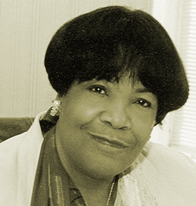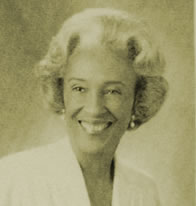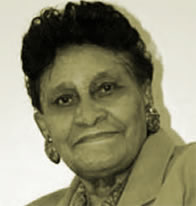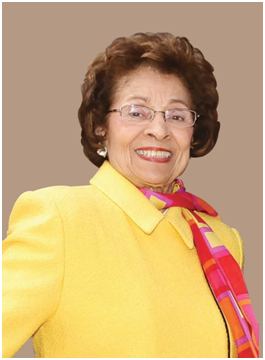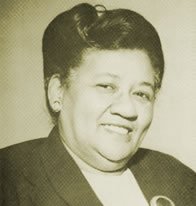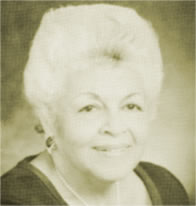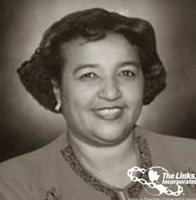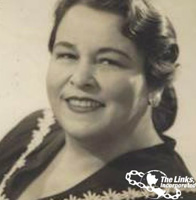
Welcome to HeartLinks
HeartLinks Signature Program
Since 2005, The Links Incorporated has proudly collaborated with the National Heart, Lung, and Blood Institute of the National Institutes of Health (NHLBI) as a Heart Truth partner. The Heart Truth campaign is a national awareness campaign for women about heart disease. The Links, Incorporated was subsequently funded by NHLBI to implement Heart Truth education programs in the African-American community, which gave rise to the HeartLinks signature program.
HeartLinks provides chapters a unique opportunity to increase awareness and educate about heart disease, and promote heart-healthy lifestyles throughout the communities we serve. The program targets African-American women in local communities and members of The Links, Incorporated in an effort to motivate women to take personal action to lower or control their risk for heart disease.
This electronic toolkit has been designed to assist chapters with implementing heart health programs. It also supports chapters in enhancing and expanding existing programs that already fit with elements of HeartLinks.
*Renamed Walk for Healthy Living
The ultimate goal is for chapters to organize healthy living programs and to collaborate with other community organizations to develop healthy habits for life.
Click the link to the Demonstration Guide below to understand how to use the HeartLinks Toolkit.
75 Million Steps Challenge
Goal: 75,000,000 steps per day leading up to 75th Anniversary Celebration ( 5,000 steps per member per day x 15,000 members = 75,000,000 per day)
Introduction
Deaths rates from heart disease, stroke, diabetes, and high blood pressure are on the rise. Research suggests that a likely explanation for this trend could be due to an increase in sedentary lifestyle, obesity (especially abdominal obesity) and psychosocial stress (imbalance between demands placed on us and our ability to manage them). There is a lot we can do to help combat this trend. Being more physically active and eating healthy, most of the time are important steps. The good news is that you can make changes gradually, one at a time.
Walking is one of the easiest and most effective of all exercises and it is a part of our daily routine. The average American walks 3,000 to 4,000 steps per day. If 10,000 is out of your reach, try to hit at least 3,000 to 7,500 steps a day along with daily activities that you enjoy and stick to it. The good news is that you don’t need to go to a gym or invest in a personal trainer or exercise equipment, all that you need to do is walk!
University of Iowa Professor Emeritus Kathleen Jantz, who studies how physical activity influences health and helped shape the federal exercise guidelines released November 2018, stated “the new federal guidelines calls for 150 minutes per week of moderate physical activity, which includes all kinds of daily movement, not just steps.”
The Challenge
- Members are encouraged to take 5,000 steps per day. If 15,000 members take 5,000 steps a day The Links, Incorporated will reach our goal 75, 000,000 step per day.
- Members should to set personal goals. Set a baseline and figure out how many steps you walk per day/week now and work up to 5,000 – 7,500 steps per day by adding on 1,000 extra steps per day every two weeks.
- Members should document their walking and progress through pictures, videos, and short stories and then share on social media using the hashtag #linksonthemove so that chapters can be recognized.
- Members should record the number of steps taken each day using an app on the smart phone, a Fitbit, or a pedometer.
- Members with mobility challenges are encouraged to participate by increasing their physical activity through chair exercises, stretching, Pilates, yoga.
- Members should check with their doctors before engaging in physical activity.
8 Things to Know About the Benefits of Walking
- Your heart is responsible for pumping the oxygen and blood around your body and keeping all the other organs working. So, it’s important to keep it in tip top condition!
- Walking not only strengthens your heart but reduces the risk of heart disease and strokes.
- A brisk 30 minute walk every day is said to reduce your risk of a stroke by 27%. It also reduces bad levels of cholesterol and increases the levels of good cholesterol too!
- 20 minutes of walking a day will burn an incredible 7lbs of body fat a year.
- An older person who walks six or more miles a week is less likely to have problems such as dementia. This is because walking has been proven to prevent your brain from shrinking.
- Walking is a fantastic way to keep active and maintain a healthy heart as it is fun, flexible and free.
- Walking is great for making you feel happy. A brisk walk can be just as beneficial as taking an antidepressant, and can be a great helping hand if you are suffering from depression, anxiety or feeling stressed.
Source: Amber W. Kinsey, PhD, Michelle L. Segar, PhD, Daheia J. Barr-Anderson, PhD
Resources
AARP – Are You Ready?
Are You Ready? Are you ready to address the financial, health and policy concerns that you face as a 50-year-old woman taking care of yourself, children, parents and/or a spouse? Are the members of your community ready?
The Are You Ready Academy is designed to provide tools and resources from a grassroots level to support African American women who are preparing for life as they age or currently dealing with the aging process. The program includes components for preventative measures during each specific life stage, in addition to immediate support and services for the 50+ community. The Academy is targeted to designated chapters geographically aligned with AARP’s priority areas (Atlanta, Chicago, Houston, Los Angeles, Miami and New York).
The program helps prepare African-American women age 50 and older to address critical issues in their life such as health, wellness and financial stability. The Academy implements a two-pronged program that addresses issues of self-readiness and caregiver readiness. Focal points of the program include:
- Exercise and diet programs
- Disease preventative care information
- Resources for preparing for retirement
- Health/Life insurance guides and information
- Health care reform education
- Caregiving, support systems and tools
- Financial planning options for self and family
- Support for current retirees
- Time and money management for self and family
- Grandparenting support and resources
HeartLinks Advocacy, Government and Other Resources
It is critical to have information on where and how to secure resources on heart health issues when developing chapter programs. It is also necessary to not only know the various governmental agencies that provide assistance with programs put how to access information. There are a variety of groups that advocate for the same health issues and building on that strength can only help to make our programs more successful. HeartLinks is listing the following contacts for the Chapter’s use and accessibility. YOU CAN CLICK ON THE SITE BELOW TO GET INFORMATION.
Advocacy
- American Heart Association www.heart.org
- www.goredforwomen.org
- WomenHeart www.womenheart.org
Government
- United States Department of Health and Human Services www.hhs.gov
- www.HealthFinder.gov
- Heart Health
- Nutrition & Fitness
- National Heart Lung & Blood Institute www.nhlbi.nih.gov/health
- Centers for Disease Control and Prevention www.cdc.gov
- Diabetes www.cdc.gov/diabetes
- Heart Disease and Stroke Prevention www.cdc.gov/dhdsp/
- Healthy Living www.cdc.gov/healthyliving
- Surgeon General Women’s Health www.womenshealth.gov
- National Institutes of Health www.nih.gov
- National Diabetes Education Program Main website www.yourdiabetesinfo.org
- Diabetes and Heart Disease tip sheet http://ndep.nih.gov/publications/Publications.aspx?PubId=127
- United States Department of Agriculture www.usda.gov
- Healthy Eating Index www.cnpp.usda.govhealthyeatingindex.htm
- USDA Center for Nutrition Policy and Promotion www.usda.cnpp.gov
- Dietary Guidelines for Americans www.cnpp.usda/dietaryguidelines.htm
Best Practice Chapters
2015 – 2016 HeartLinks/Heart Truth Community Action Program Grant
Tier 1 – Intervention Sites
Six chapters were recruited for the HeartLinks/Community Action Program Grant. These chapters participated in the program planning, -management and -evaluation training. The chapters were located in the four geographical areas of The Links’ membership constituency, namely the Eastern, Southern, Central and Western regions. The six intervention sites are: Arlington, VA (including metropolitan Washington, DC); Asheville, NC; Nashville, TN; Omaha, NE; Roanoke, VA; and Texas Spring Cypress (Houston), TX. These chapters were specifically targeted for two reasons. First, they are situated in urban, rural and southern locales characterized by documented social, cultural and environmental contextual factors that put African American women at higher risk for cardiovascular disease. High prevalence and -mortality rates from coronary heart disease among African Americans are reported in all these states, three of which are located in the Stroke Belt—Virginia, North Carolina and Tennessee. Second, the identified chapters have strong ties to the respective underserved communities through their established record of community program. The profiles in this section describe the HeartLinks program sites’ program design and implementation, and key program activities and accomplishments.
Tier 2 – Awareness Sites
The members of the four Area Program Committees, in collaboration with the Area HeartLinks Chairs (i.e., Eastern, Southern, Central and Western), identified 24 Chapters to serve as HeartLinks Awareness sites. The Awareness Link Chapters were required to have previously hosted a Red Dress event. The Program profiles included in this section list the sites accomplishments and planned activities and reflect their community partner collaborative and heart health awareness and educational activities.
Click the name of the chapter below to learn more:
- Augusta (GA)
- Beverly Hills West (CA)
- Birmingham (AL)
- Brooklyn (NY)
- Brunswick (GA)
- Greater Miami (FL)
- Huntington (WV)
- Lansing/East Lansing (MI)
- Middlesex County (MA)
- Missouri City Chapter (TX)
- Mississippi Delta (MS)
- North Broward County (FL)
- Oakland County (MI)
- Palos Verdes (CA)
- Phoenix (AZ)
- Rancocas Valley (NJ)
- Syracuse (NY)
- Tacoma (WA)
- Toledo (OH)
- Topeka (KS)
- Washington (DC)
- Waterbury (CT)
- Youngstown (OH)
2009 – 2010 Heart Truth Community Action Grant
The Heart Truth Community Action Program, HeartLinks to Heart Health (HeartLinks) program, was designed to target African American women in underserved communities to measurably increase participants’ awareness of risk factors for heart disease and effect behavioral change related to risk behavior. Six Links chapters across the U.S. served as program sites.
The program sites represented the following Links chapters: Arlington, Virginia (including the metropolitan Washington, DC area); Columbus, Ohio; Buckhead/Cascade, Georgia (including the metropolitan Atlanta, Georgia area); Pontchartrain, Louisiana (New Orleans, Louisiana); North Texas Cluster comprised of the Fort Worth, Texas, Mid-Cities, Texas and the Plano North Metroplex, Texas chapters; and Sacramento, California. The six sites were divided into two cohorts. Cohort I was comprised of the three chapters that participated in an earlier Heart Truth Women of Color pilot program, namely Arlington, VA, Columbus, OH and North Texas Cluster, TX. Cohort II consisted of the three new chapters, namely Buckhead/Cascade, GA, Pontchartrain, LA and Sacramento, CA. These chapters were specifically targeted for two reasons. First, they are situated in urban, rural and southern locales characterized by documented social, cultural and environmental contextual factors that put African American women at higher risk for cardiovascular disease. Second, the identified chapters have strong ties to the respective underserved communities through their established record of community program implementation.
Click the name of the chapter below to learn more:
HeartLinks/Diet Coke: Flag Heart Disease
Diet Coke has embraced the Heart Truth Program by making funds available to Heart Truth partners to raise awareness about the importance of heart health.
On February 14, 2011 Diet Coke hosted a campaign event at the Georgetown University Law Center Sports & Fitness Center in Washington, DC. The event featured a “Capture the Flag” game, to help bring the “heart flag” imagery to life and create awareness about the campaign. This game made a direct impact as the four teams competed for funding for selected Heart Truth partners. The Links, Incorporated won first place and received $10,000.00 to expand the HeartLinks to Heart Health Program.
“Flag” Heart Disease Incentive Grant Program
The Links Foundation through a competitive grant application process provided small grants to chapters to spread the Heart Truth to women in their communities and implement interventions that encourage behavior change leading to the lowering of heart disease risk.
During the 38th National Assembly in Orlando, the Health and Human Services Facet hosted a Health Pavilion that showcased the Facet’s Signature Programs and Initiatives, and supporting partnerships. A poster session format was used to spotlight the accomplishments of the 20 HeartLinks/Diet Coke grantees.
Following are program summaries of the 20 winning chapters:
Family and Childhood Obesity
The reality of weight management and obesity among Africans is startling! At every age, blacks are more likely to be obese than whites, according to data from the Journal of the American Medical Association. Comparative data are alarming. And, the collateral damage is profound and includes high blood pressure, high levels of blood fats, LDL cholesterol and other integral and significantly related health issues.
Click the link to the pdf below to find out more information.
Health Disparities
Social Determinants of Health and Health Disparities:
The Persistence of Racial Disparities Impact on Health
Overview
In 2003, a well-documented study by the Institute of Medicine titled Unequal Treatment: confronting Racial and Ethnic Disparities in Health Care established that health disparities are significant and persistent between whites and all other racial and ethnic minorities. The Institute of Medicine defines these disparities as “differences in the quality of health care that are not due to access-related factors or clinical needs, preferences, and appropriateness of interventions.” These health disparities burden African Americans and others
The reasons for these disparities or inequities in health access, treatment and outcomes are “diverse, complex, evolving and interdependent.” Often, these health disparities experienced by racial and ethnic minorities are referred to as the social determinants of health. These social determinants are conditions in the places where people live, learn, work, and play that affect a wide range of health risks and outcomes, including the following:
- Safe housing, transportation, and neighborhoods
- Racism, discrimination, and violence
- Education, job opportunities, and income
- Access to nutritious foods and physical activity opportunities
- Polluted air and water
- Language and literacy skills
These health inequities lead to poor access to primary care physicians, health insurance, health professionals who are culturally competent, poor health outcomes, and circumstances where they live, learn, and work where unable to improve their health.
Source: CDC, Healthy People 2030
Health Disparities and COVID-19
The pandemic vividly exposed the massive inequities in our health care system and the adverse and enduring impact these inequities that result from the social determinants of health have on communities of color. According to an analysis by the Kaiser Family Foundation and the Epic Health Research Network, based on data from the Epic health record system for 7 million Black patients, 5.1 million Hispanic patients, 1.4 million Asian patients, and 34.1 million white patients, as of July 20, 2020, the hospitalization rates and death rates per 10 000, respectively, were 24.6 and 5.6 for Black patients, 30.4 and 5.6 for Hispanic patients, 15.9 and 4.3 for Asian patients, and 7.4 and 2.3 for white patients. American Indians living in the US also have been disproportionately affected by COVID-19. Racial and Ethnic Disparities Related to COVID-19
There were several factors leading to higher risk of death among Black patients, for example, then the larger population of COVID infected White patients. Many Blacks worked in jobs that were deemed essential such as public transportation, hospitals, or grocery stores and did not have the luxury of working remotely from home. They used public transportation rather than private vehicles or Uber. If a member of the family was infected, they had limited means of segregating or isolating the family member so that he or she did not expose other family members. Many Blacks who are low-income are at higher risk of having hypertension, diabetes, and obesity and all three are associated with worse outcomes among patients with SARS-CoV-2 infection. Racial and Ethnic Health Disparities Related To COVID-19 “In addition, racial and ethnic minority populations have poorer access to health care, which likely results in persons initiating care later in the course of their illness with COVID-19.” Id. Even with the availability of the vaccine, there is a consistent pattern of Blacks receiving smaller shares of vaccinations resulting in lower vaccination rates compared to whites. These disparities in vaccinations reflect the longstanding inequities that create increased barriers to health care for people of color and other underserved groups such as the difficulty of getting access to the vaccine because of limited public transportation, fewer health care providers in the community, or inability to get information about the availability of the vaccine.
Responding to Health Disparities
The response to correcting or eliminating these health disparities requires a multi-prong approach to address historic patterns of housing segregation and discrimination, lack of educational equity, providing economic and employment opportunities within communities of color that allow for a livable wage, and access to health care by a workforce that has addressed its cultural and ethnic biases.
Even given persistent Health Disparities, you can take action.
What can an individual do to help themselves? Healthy eating + Movement = Healthier Heart
Healthy Eating: More complex than merely saying eat better. Recognize that choosing what to eat is as much as a cultural and economic choice, i.e., what can one afford. However, this is a vitality important issue to tackle to address some of the key risks to your heart – hypertension, diabetes, and obesity. Eating more vegetables, fruits, whole grains, less sodium and fish, skinless chicken or lean beef will help you to feel better and lose weight.
Move!
Reduce weight
Reduce blood pressure or hypertension
Reduce cholesterol
Submitted by:
Okianer Christian Dark, J.D, Silver Spring (MD) Chapter
Professor of Law, Howard University
HeartLinks and Walk for Healthy Living Signature Programs Committee Member
EMBRACING WELLNESS… Decision time for a new way forward
What we HAVE AVAILABLE to eat VERSUS what we can CHOOSE to Eat … will inform individual and family nutritional selections.
Racial Disparities, Health Inequity, COVID and More
According to the U.S. Department of Health and Human Services Office of Minority Health, African American adults are 60% more likely than non-Hispanic white adults to have been diagnosed with diabetes by a physician, 20% more likely to die from heart disease, 40% more likely to have high blood pressure, 50% more likely to have a stroke, and have the highest mortality rate of any racial and ethnic group for all cancers combined and for most major cancers. https://www.pcrm.org/good-nutrition/healthy-communities/black-health. The health disparities in nutrition and obesity correlate closely with the alarming racial and ethnic disparities related to COVID morbidity and mortality.
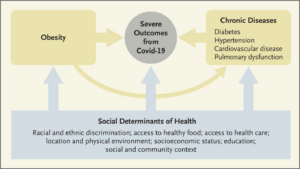
Plant-Based Diet Benefits Black Health
The history of plant-based eating among African populations highlights the important role traditional diets have played in reducing the burden of chronic diseases.
African Americans in a research study who consumed a vegetarian/vegan diet had fewer heart disease risk factors including lower blood pressure, half the risk of diabetes, and a 44% reduced risk for hypertension. Vegetarians and vegans were also 43% less likely to be obese, compared with nonvegetarians though outstanding results have been seen in consumption of a mixed meal and snack pattern of nutrition. Numerous resources exist
https://www.pcrm.org/good-nutrition/healthy-communities/black-health
Eating the Rainbow… A simplified roadmap to health
RED: Improves memory and heart health; lowers risk for some cancers.
ORANGE: Vitamin A keeps our eyes, bones, and immune system healthy.
YELLOW: Can help prevent macular degeneration.
GREEN: Lowers risk for some cancers; strengthens our bones and teeth.
BLUE & PURPLE: Maintain brain and heart health.
To eat the rainbow, incorporate two to three different-colored fruits or vegetables at every meal and at least one at every snack. While you don’t have to eat every single color every day, try to get them into your diet a few times per week. Keep it colorful! Quick and easy meal and snack suggestions are found by referring to the attached link. https://www.healthline.com/nutrition/eat-the-rainbow
Rainbow Salsa Recipe
https://skipthesalt.com/rainbow-salsa/
In the name of BEETS
https://thebeet.com/category/recipes/
How about a bowl of pickled beets instead of a bowl of ice cream?
https://www.healthline.com/nutrition/are-pickled-beets-good-for- you#nutrients
Eat the Rainbow with chicken recipes:
https://www.hallmarkchannel.com/home-and-family/recipes/eat-the-rainbow- one-pan-roasted-chicken-veggie-dinner
https://www.wellplated.com/sheet-pan-chicken-rainbow-vegetables/
Eat the Rainbow with seafood recipes:
https://dishonfish.com/mustard-glazed-salmon-with-cauliflower-mash-and- spinach/
https://damndelicious.net/2017/02/27/sheet-pan-garlic-butter-tilapia/
Submitted by:
Henrie Monteith Treadwell, Ph.D., Atlanta (GA) Chapter
Research Professor, Department of Community Health and Preventive Medicine, Morehouse School of Medicine (MSM)
HeartLinks and Walk For Healthy Living Signature Programs Committee Member
HeartLinks Educational Program
Utilizing “With Every Heartbeat Is Life”
HeartLinks education training sessions are designed to provide educational information dissemination, which ultimately leads to a greater knowledge of cardiovascular disease, its impact on African American women, and steps to take to decrease risk and risk factors.
HeartLinks educational sessions utilize “With Every Heartbeat Is Life,” a heart health manual created for African American communities by the National Heart, Lung, and Blood Institute, National Institutes of Health.
Download Manual (adobe acrobat required)
Download Picture Cards(adobe acrobat required)
This toolkit for community health workers includes a manual and companion flipchart for a 12-lesson course on heart health education tailored to African American communities. The With Every Heartbeat Is Life manual comes complete with activities, group activity idea starters, and reproducible handouts, and the illustrated flipchart can be used as teaching tool to help lead the course. Topics covered include understanding heart disease and heart attack, reducing risk factors, and protecting your heart.
Additional Resources:
- Move More Fact Sheet
- Know the Difference Fact Sheet
- DASH Eating Plan
- Taking Care of Our Hearts, Together
For information on how to obtain this manual, contact www.nhlbi.nih.gov.
HeartLinks Program Partners
Information on this segment of the HeartLinks Toolkit will be provided in the coming weeks.
Oral Health
Saving Smiles, Saving Lives
Dental disease has been linked to:
- Cardiovascular disease
- Diabetes
- Pregnancy risks and low birth weight babies
- Dementia and Alzheimer’s
- Respiratory infections and pneumonia
- Immune system disorders
- Bone density
The Link between Oral Health and Overall Health
- Cardiovascular disease: heart disease.
Bacteria from inflammation of the gums and periodontal disease can travel to the arteries in the heart and cause atherosclerosis (hardening of the arteries). - Dementia: The bacteria from gingivitis may enter the brain through either nerve channels or through the bloodstream, that might even lead to the development of Alzheimer’s disease.
The Heart Truth: A Campaign for Women About Heart Disease
The Heart Truth® is a national education program for women that raises awareness about heart disease and its risk factors and educates and motivates them to take action to prevent the disease. Through the program, launched in 2002, the NHLBI leads the Nation in a landmark heart health movement embraced by millions who share the goal of better heart health for all women. The centerpiece of The Heart Truth is the Red Dress®, a national symbol for women and heart disease awareness that was created by the NHLBI and introduced in 2002. The Red Dress serves as a powerful source of inspiration for women to learn more about their personal risk for heart disease and take action to protect their heart health.
One in five women in the United States die from Heart Disease. The most common type of heart disease is coronary heart disease, also called clogged arteries. It causes heart attacks and is the #1 killer of women in the United States. Healthy eating and physical activity go a long way to preventing heart disease, and keeping it from getting worse if you already have it. There is a lot you can do to protect your heart.
Taking Small Steps for a Healthy Blood Pressure
NHLBI’s The Heart Truth® program is featuring a variety of new educational resources that focus on healthy lifestyle changes you can make, little by little, to help you in your efforts. Materials are free and available on NHLBI’s High Blood Pressure web page. Here’s what you will find:
- A Healthy Blood Pressure for Healthy Hearts fact sheet that provides an overview of high blood pressure and what to do to prevent or control it. Keep track of your blood pressure numbers with its companion worksheet.
- A new series of DASH eating plan fact sheets, sample menus, recipes, and tips to reduce salt and sodium. These user-friendly materials will make it easier for you to follow this NHLBI-developed eating plan, which research proves can lower your blood pressure and LDL cholesterol.
- Social media images and posts that are ready to share. Use them to educate others about how to control and prevent high blood pressure, one step at a time.
- An updated Delicious Heart Healthy Eating web page that features more than 100 heart-healthy recipes, as well as information about how to food shop and cook healthy meals for the entire family. Check out our latest cooking demo of two easy-to-prepare, DASH-friendly recipes.
Our Hearts Are Healthier Together! Encourage a friend, family member, or coworker to join you on your journey to a healthier heart. Research has shown that having strong social support can make it easier to stay motivated and reach your health goals. Visit NHLBI’s Our Hearts map and get inspired by the activities of others around the country, then share what you’re doing to prevent or control high blood pressure, using #OurHearts.
Want more? Visit NHLBI’s High Blood Pressure web page or our High Blood Pressure Education Toolkit to find more resources about high blood pressure and heart-healthy lifestyles.
Click on www.nhlbi.nih.gov/heartmonth and www.nhlbi.nih.gov/health-topics/education-and-awareness/heart-truth to learn more about heart disease, high blood pressure, high blood cholesterol, how to find out if you’re at risk, and how to protect your heart.
What is CPR?
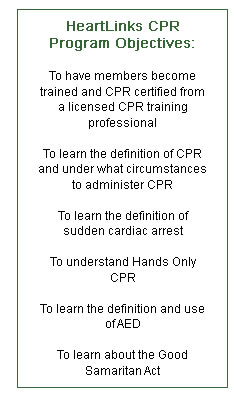 Cardiopulmonary Resuscitation (CPR) is a combination of providing rescue breathing and chest compressions to victims thought to be in cardiac arrest. It is generally done in ongoing cycles by providing 30 chest compressions followed by 2 rescue breaths. When cardiac arrest occurs, the heart stops pumping blood. CPR can support a small amount of blood flow to the heart and brain to “buy time” until normal heart function is restored.
Cardiopulmonary Resuscitation (CPR) is a combination of providing rescue breathing and chest compressions to victims thought to be in cardiac arrest. It is generally done in ongoing cycles by providing 30 chest compressions followed by 2 rescue breaths. When cardiac arrest occurs, the heart stops pumping blood. CPR can support a small amount of blood flow to the heart and brain to “buy time” until normal heart function is restored.
Note: CPR Training should always be conducted by a licensed CPR training professional.
Why Links Should Be Interested in CPR?
An estimated 92 percent of sudden cardiac arrest victims will die before reaching the hospital. If more people know how to perform CPR and provide immediate action, a victim’s survival rate could double or triple. More lives could be saved if more individuals understood CPR situations and were willing to respond in an emergency.
Importance of CPR
If someone went into cardiac arrest in front of you, would you know how to help?
- Bystanders can help. Unnecessary deaths can occur, when people don’t act upon seeing someone suddenly collapse.
- Your action to respond can only help. If you see an unconscious adult and have not been CPR trained, call 9-1-1.
Sudden Cardiac Arrest
Sudden Cardiac Arrest is a leading cause of death in the United States claiming nearly 300,000 lives each year. During sudden cardiac arrest, the heart function ceases abruptly and without warning. When this occurs, the heart is no longer able to pump blood to the rest of the body. In 95 percent of sudden cardiac arrest victims, death occurs.
When an adult has a sudden cardiac arrest, the person’s survival depends greatly on immediately receiving CPR. A bystanding witness can help. Unfortunately, less than 1/3 of people who experience a cardiac arrest at home, work or in a public location will receive help that can be provided.
Why? Many bystanders are worried that they might do something wrong or make things worse.
Hands Only CPR
Hands Only CPR is CPR without rescue breathing. Hands Only CPR makes responding to an adult who suddenly collapses from sudden cardiac arrest a 2 – step process that most people can do. To find out more information, go to http://handsonlycpr.org/.
The benefit of Hands Only CPR is that it is easy to remember and the action can only help.
AED
An automated external defibrillator or AED is a device that automatically diagnoses the potentially life threatening cardiacarrhythmias of ventricular fibrillation and ventricular tachycardia in a person. It is not necessary for the rescuer to be able to identify heart rhythms. If a shockable rhythm is detected, the machine will be able to treat them through defibrillation. This occurs through the application of electrical therapy which stops the arrthymia allowing the heart to reestablish an effective rhythm.
Who can use an AED and how does it work? By listening to voice prompts, almost anyone can use an AED. Once the machine is turned on, the rescuer will be prompted to apply two electrodes provided with the AED to the victim’s chest. After the pads are applied, the AED will begin to monitor the victim’s heart rhythm. If a shockable rhythm is detected, the machine will charge itself and instruct the rescuer to stand clear of the victim, followed by a voice prompt to press the shock button.
Good Samaritan Provisions
Did you know?
It has been reported that all 50 states now have AED Good Samaritan provisions that help protect laypersons that have been properly trained to use these devices. Therefore, any layperson who has been trained to use an AED may be afforded some protection under applicable AED Good Samaritan provisions. Contact your local or state emergency medical services (EMS) department to find out about Good Samaritan protections that your state provides for users of AEDs.
Become Certified In CPR
- American Heart Association
- Local Hospital in your community
- Local Fire Department in your community
Diabetes & Heart Disease
Diabetes and Its Relationship To Heart Disease: A Brief Overview
The purpose of this overview is for informational and educational purposes only. It is strongly advised that you consult with your health care provider in regard to the health treatment plan that is best for you.
What Is Diabetes?
Diabetes is a disease that occurs when your blood glucose (also known as blood sugar) is too high. Our blood glucose is the primary source of energy for our bodies and is derived from the foods we eat. Insulin, a hormone made by a gland known as the pancreas, helps glucose from the food we eat get into our cells to be used for energy. In the case of diabetes, our body either 1) does not make enough insulin 2) does not make insulin at all or 3) does not use insulin well. As a result, the glucose stays in your blood and does not reach your cells. Over time, having too much glucose in your blood can cause health problems – _such as heart disease.
Types of Diabetes
The most common types of diabetes are type 2, gestational, and type 1.
Type 2 – _In type 2 diabetes, either your body does not make enough insulin or it does not use properly the insulin that your body does make. It can be developed as a child or in adulthood but most commonly in middle-aged and older adults. It is the most common type of diabetes. Treatment may include lifestyle changes, oral medication or injectable medications (insulin or non-insulin).
Gestational – This form of diabetes may develop during pregnancy. It usually resolves itself after pregnancy. However, if you have had gestational diabetes, there is a greater chance of developing type 2 diabetes later in life.
Type 1 – In type 1 diabetes, your body does not make insulin. The immune system attacks and destroys the cells in the pancreas that make insulin. It is usually diagnosed in children and young adults. People with type 1 diabetes need to take insulin every day to stay alive.
Type 2 Diabetes in African Americans
- Type 2 diabetes is an epidemic in African American communities
- 9 million African-American adults, or 18.7% of all African Americans greater than 20 years of age, have diagnosed or undiagnosed diabetes, compared to 7.1% of non-Hispanic white Americans
- The risk of diabetes is 77% higher among African Americans than among non-Hispanic white Americans. This is felt to be in large part due to sedentary lifestyle, poor dietary habits and obesity.
Obesity in African American Women
- Obesity has risen to epidemic proportions in the African American community
- Obesity is a significant risk factor for development of Type 2 diabetes and other health ailments
- Approximately 60 percent of black women are obese, compared with 32 percent of white women and 41 percent of Hispanic women
- Obesity is decreasing black women’s life expectancy and increasing their chances of developing a host of ailments, including diabetes, cardiovascular disease and arthritis
Gestational Diabetes in African American Women
- African American women are disproportionately afflicted with gestational diabetes and face a 52 percent increased risk of developing type 2 diabetes in the future compared to non-Hispanic Caucasian women
The NIDDK’s website, www.niddk.nih.gov, has a wealth of information on diabetes (management and type 2 diabetes prevention, including content on diabetes-related heart disease and stroke and gestational diabetes), weight management (including content specific to overweight children).
Message to women who have a history of gestational diabetes that they – and their child born from a pregnancy affected by gestational diabetes – have an increased lifelong risk for developing type 2 diabetes. Click Here, to find messages and materials about gestational diabetes.
The NIDDK’s Sisters Together: Move More, Eat Better national health awareness program features a PDF and video that you can use/adapt to encourage African American women to reach and maintain a healthy weight by getting regular physical activity and learning healthier food choices.
How are diabetes and heart disease related?
Over time, high blood sugar levels can cause damage to your blood vessels as well as damage the nerves that control your heart and blood vessels. In addition, high blood sugar levels can cause blood vessels to become stiff and hard. The longer that you have diabetes, the greater the chance that you will develop heart disease.
Diabetes and Heart Disease statistics
- 68% of persons over 65 years old with diabetes die from some form of heart disease
- Adults with diabetes are 2-4 times more likely to die from heart disease than without diabetes
- Women with diabetes have a 40% greater risk of developing heart disease than men
- Diabetes is the 7th leading killer of Americans
- Heart disease is the leading cause of death for both men and women
The Good News – You can protect your heart and control (prevent) diabetes!
- Be Active – _30- 45minutes of aerobic exercise most days of the week
- Stop Smoking – _smoking increases risk for multiple health conditions including heart disease
- Lose weight – _losing even a small percentage of your weight can reduce heart disease risk
- Manage cholesterol – _Your bad (LDL) cholesterol should be less than 100
- Manage blood pressure – _Ideal blood pressure is 120/80 or less.
- Eat healthy – _reduce foods high in saturated fat, trans fat, salt, and cholesterol such as fried foods, red meats, and eggs. Instead focus more on high fiber foods such as whole grains, vegetables, and fruits
- Control your diabetes – _Diabetes can be controlled thus significantly reducing your chances of heart disease. Follow the diabetes management plan that you and your doctor have agreed upon including lifestyle changes and medication compliance
FOR MORE INFORMATION:
https://www.nhlbi.nih.gov/health-topics/diabetic-heart-disease
https://www.mayoclinic.org/diseases-conditions/type-2-diabetes/symptoms-causes/syc-20351193
https://www.cdc.gov/heartdisease/facts.htm
https://www.heart.org/en/health-topics/diabetes/why-diabetes-matters/cardiovascular-disease–diabetes
http://www.diabetes.org/living-with-diabetes/complications/heart-disease/
https://www.everydayhealth.com/heart-health/heart-disease-and-diabetes.aspx
https://www.cdc.gov/nchs/fastats/black-health.htm
https://minorityhealth.hhs.gov/omh/browse.aspx?lvl=4&lvlid=18
Submitted by:
Link Kimbra Bell Balark, MD
Chicago (IL) Chapter
Member, HeartLinks and Walk for Healthy Living Signature Programs Committee
Physical Activity, Nutrition, and Heart Disease
Heart disease is the leading cause of death for women in the United States, killing 289,758 women in 2013—that’s about 1 in every 4 female deaths. Heart disease is largely preventable, but most people don’t take the necessary steps to reduce their risk. Some of the factors that increase the risk of developing heart disease, include high blood pressure, diabetes, and obesity. Even though many of us know what to do to improve our heart health, research shows that knowing is not enough; we need to act. Reducing risk and optimizing health means changing behaviors to adopt healthier lifestyles.
- Lower your risk for heart disease by managing your cholesterol
- Regular physical activity, such as walking, is a great way to prevent heart disease and stroke
- People living with type 2 diabetes have an increased risk for developing heart disease
- Obesity and being overweight increase your risk for cardiovascular disease
Watch national president, Link Kimberly Jeffries Leonard’s Moving Story.
To learn more about a heart healthy lifestyle click on the link below:
Creating Virtual Physical Activity Programs
- Virtual Annual Walk for Healthy Living_25th Year_Overview
- Virtual Walk for Healthy Living and 75 Million Step Challenge Guide
- HOME ALONE
- Walk for Healthy Living Virtual Publicity Plan
- Walk for Healthy Living Virtual Publicity PowerPoint
- Virtual Communications Tips
Creating Healthy Eating Programs
- Introduction – Healthy Eating Guide
- HeartLinks Healthy Eating Virtual Program Guide
- Nutrition and Obesity in the Era of COVID-19
- Building a Balanced Plate – Adults and Children
- Stuffed Peppers Cooking Demonstration
- Stuffed Peppers Recipe
- Muesli Cooking Demonstration
- Muesli Recipe
- Moroccan Chicken
- Pantry Must Haves
- Healthy Eating Virtual Communications
Resources
Red Dress Initiatives
Heart Disease Doesn’t Care What You Wear –
It’s the #1 KILLER OF WOMEN
The Red Dress is the national symbol for women and heart disease awareness and the centerpiece of The Heart Truth – a national awareness campaign that warns women about their risk of heart disease and inspires them to take action and lower risk. The Heart Truth is sponsored by the National Heart, Lung, and Blood Institute, part of the National Institutes of Health, U.S. Department of Health and Human Services.
Event Ideas
- Organize a “Wear Red Day” or “Women Heart Day” by incorporating it into an annual chapter event, i.e. fundraiser breakfast, luncheon or dinner.
- Plan a “Wear Red Day” for your February chapter meeting.
- Plan a “Wear Red Day” for your church.
Sample Red Dress Activities
HeartLinks to Heart Health Tier 2 Chapters
Click on the link to see chapter profiles:
- Augusta (GA)
- Beverly Hills West (CA)
- Birmingham (AL)
- Brooklyn (NY)
- Brunswick (GA)
- Greater Miami (FL)
- Huntington (WV)
- Lansing/East Lansing (MI)
- Middlesex County (MA)
- Missouri City Chapter (TX)
- Mississippi Delta (MS)
- North Broward County (FL)
- Oakland County (MI)
- Palos Verdes (CA)
- Phoenix (AZ)
- Rancocas Valley (NJ)
- Syracuse (NY)
- Tacoma (WA)
- Toledo (OH)
- Topeka (KS)
- Washington (DC)
- Waterbury (CT)
- Youngstown (OH)
Walk for Healthy Living Signature Program
(Formerly Project Walking Fête: Make Health a Habit)
Welcome to Walk For Healthy Living! This program has everything you’ll need to get started on your journey to good health.
For more than 25 years, The Links, Incorporated has engaged in creative programs that address many aspects of cardiovascular disease (CVD) risk factors. In 1995, The Links, Incorporated was one of nine national organizations selected to participate in the launch of the country’s first national physical activity initiative, Project Walking Fete: Make Health A Habit*, through a grant award from the Centers for Disease Control and Prevention.
27th Annual Walk-A-Thon
Begin your chapter year by participating in our 27th Annual Walk-a-Thon.
Since 1995 the National Walk-A-Thon usually takes place on the last Saturday of September. The 2022 Annual Walk-a-Thon is scheduled for Saturday, September 24. The Walk-a-Thon gives chapters an opportunity to not only raise money for local programs but it also promotes walking as a healthy pastime. The ultimate goal is to promote physical activity and educate our communities about the importance of regular physical activity in improving overall health and wellness. Let’s do our part and collaborate with Link chapters, schools, churches, local businesses, other organizations and all citizens to participate in the Walk-a-Thon and other chapter activities that promote physical fitness.
Walk-A-Thon Timeline and Forms to Complete
National Poster Art Competition
The National Poster Art Competition is designed to encourage children to focus on the benefits of good nutrition, healthy living, and physical activity. For more information about contest rules and implementation, visit the documents section of Members Only.









































